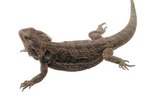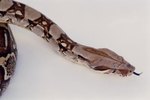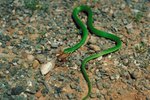
A pet snake sleeping or lounging in his or her water bowl, in many cases, is no cause for alarm. In other instances, it can indicate stress or illness. When confronted with a soaking snake, the important thing is to decide if the soaking is symptomatic of a problem or is merely a normal, healthy snake soak.
Natural Behavior
Many snakes have evolved to live in or near the water. It is to be expected that such captive snakes will spend prolonged periods of time in their water dishes. Anacondas (Eunectes murinus), North American water snakes (Nerodia sp.) and Asian water snakes (Enhydris sp.) are among the species commonly kept as pets that spend prolonged periods of time in the water. For these species, provide a water dish large enough to allow complete submersion, and clean the water frequently.
High Temperatures
When a species not known for soaking is found in his water dish, it is important to check the cage temperatures. High cage temperatures can quickly become lethal, and a rat snake's critical thermal maximum is only about 100 degrees Fahrenheit, at which point the snake loses muscle tone. Once temperatures climb past about 90 degrees Fahrenheit, a rat snake's voluntary thermal maximum, he will seek cooler temperatures, and the water dish is often his last resort. It is important to reduce dangerously high temperatures immediately to prevent serious health problems or death.
Shedding
When snakes shed, they require more water than normal. In the wild, snakes that are entering a shed cycle will drink frequently and seek out a damp retreat to retard water loss. In captivity, when provided with no other option, snakes will soak in their water dish to remain well hydrated. If you'll provide a damp hide box, many snakes will opt to go inside rather than soak in a water dish.
Humidity Issues
Many rainforest species require high humidity to remain stress-free. If the overall humidity drops too low in a captive habitat, these species may retreat to the water dish. Notable species engaging in this behavior include rainbow boas (Epicrates spp.) and viper boas (Candoia asper). To combat this, mist the enclosure with room temperature water regularly. Reducing ventilation is another option for raising a habitat's relative humidity, but you must do it with care to ensure adequate air exchange. If you reduce the ventilation, condensation may appear on the cage glass or walls. While small patches of condensation aren't a problem, too much condensation will encourage fungal and bacterial growth. If large patches of condensation appear, it will be necessary to increase the ventilation.
Mites
One of the most frustrating causes for a snake's excessive soaking is the presence of mites. Snake mites are ectoparasites of snakes, somewhat akin to fleas. A snake with mites soaks in its water dish in an effort to drown the mites. In practice, the soaking does drown some mites but not enough to eliminate the problem. If a snake soaks excessively, and the behavior can’t be attributed to an environmental cause, have the snake checked for mites.
References
- Melissa Kaplan's Herp Care Collection: Signs of Illness and Stress in Reptiles
- Biological Conservation: Using Thermal Ecology to Predict Retreat-Site Selection by an Endangered Snake Species
- Reptiles-n-Critters: Green Anaconda Care Guide
- Applegate Reptiles: Shedding
- Journal of Thermal Biology: A Test of the Thermal Coadaptation Hypothesis With Black Rat Snakes (Elaphe obsoleta) and Northern Water Snakes (Nerodia sipedon)
Photo Credits
-
Tom Brakefield/Stockbyte/Getty Images




